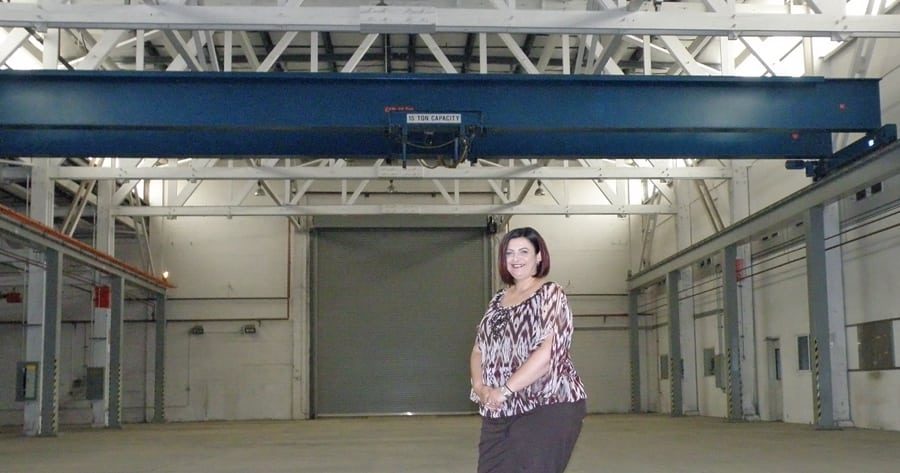
Home » Big Pasco Industrial Center offers blank slate of possibilities
Big Pasco Industrial Center offers blank slate of possibilities

June 15, 2017
Occupancy rates have ranged from 57 percent to 87 percent in past five years
When the Port of Pasco’s director of properties walks around the huge warehouses in the Big Pasco Industrial Center, she sees business possibilities.
[blockquote quote="We’d like to see more manufacturing. More manufacturing brings greater employment." source="Mayra Reyna, Port of Pasco’s director of properties" align="right" max_width="300px"]
“I see a lot of potential. Every time I walk through, I try to think outside the box,” said Mayra Reyna. “(The port) welcomes new ideas and new thoughts on business.”
Most of the eight warehouses at the 370-acre riverfront complex on Ainsworth Avenue are subdivided into four bays with firewalls in between. Each of the bays is 43,200 square feet, or almost an acre.
Finding tenants for the large spaces has been a challenge, with higher vacancies than the port would like to see, Reyna said. Occupancy rates have ranged from 57 percent to 87 percent in the past five years.
“But all of our small buildings at Big Pasco have waiting lists. After the recession, no one wanted to take a gamble on the big spaces,” she said.
The port’s industrial park at the Tri-Cities Airport, which offers smaller size properties for lease, is at 100 percent capacity and also has a waiting list.
Most businesses seeking port property want 5,000 square feet to 10,000 square feet of space, Reyna said. That’s why the port is considering subdividing the large warehouses.
Big Pasco’s location should be attractive to businesses, Reyna said, as it is the city’s only heavy industrial zone and it is close to the freeway and points beyond.
“One of the tenants we have moved here because it was a mid-point between Spokane and Hermiston. We have the infrastructure,” Reyna said.
Big Pasco has 15 miles of rail line connecting to BNSF Railway, a barge slip and broadband fiber.
Monthly lease rates range from 22 cents per square foot to 32 cents per square foot, depending on building amenities and the land, Reyna said.
The port tries to keep its lease rates lower “so tenants can adapt the buildings to their needs. We try to keep our rates competitive within the market,” she said.
Some of the warehouse bays have had tenant improvements in the past.
“(The space) works great for manufacturing. Some of them have offices, restrooms and conference rooms,” Reyna said. “We’d like to see more manufacturing. More manufacturing brings greater employment.”
The warehouses also work very well for storage, for obvious reasons: they’re covered and big.
“We have a variety of tenants who specialize in warehousing,” Reyna said.
Mid-Columbia Warehousing is one of the port’s oldest tenants.
Zen-Noh Hay Inc., a Japanese-based company, leases 30 acres on a long-term basis for hay storage.
Propak, a national company, makes pallets for Walmart and it’s been expanding steadily, Reyna said. It supplies pallets for local Walmarts, as well as throughout the region.
Another tenant wood-chips the old pallets to make mulch. Reyna said she likes this symbiotic relationship between tenants who work with one another.
The warehouses also have been used as business incubators over the years.
The port leases to a mix of private companies and public agencies. Among its tenants are the Pasco School District, Franklin County, National Oceanic and Atmospheric Association, Lampson Crane, Aromatics LLC, Miramac, and Safety-Kleen, a national company that’s the largest re-refiner of used oil and provider of parts cleaning services in the country.
“Sometimes a private company may be intimidated by leasing from a government agency, but we are here to make that process easier. We offer lease and broker incentives,” Reyna said.
The port offers a variety of lease options as well, term leases and month-to-month leases, Reyna said.
“Of course, the port likes to have longer term leases. However, when you have projects coming and going, we adapt,” she said.
The large warehouse complex was built in 1942 by the U.S. government as one of 10 holding and re-consignment points in the U.S., serving both the ports of Portland and Seattle during World War II, as well as during the Korean conflict.
Supplies were sent to the Soviet Union and among the shipments sent through Pasco were $1 million worth of surgical equipment, train carloads of cigarette papers, as the Russians rolled their own, a carload of gold braid, chemicals of all kinds, brass and copper items and semolina flour, according to an article about Big Pasco published by the Franklin County Historical Society in 1984.
The port acquired the facility for $800,000 in 1959.
The buildings also housed about 300 Italians released from prisoner of war camps to work for the government from 1944-45 because of a worker shortage.
The buildings have begun to show their age but the port budgets annually for improvements and several tenants also have developed the buildings for their own business purposes.
As Reyna walked around the warehouses recently, she pointed out the various improvements — from overhead bay doors and heaters, to exhaust systems, new roofs and concrete loading docks.
“It’s a great facility and it’s ready for growth,” she said.
Local News Manufacturing
KEYWORDS june 2017




